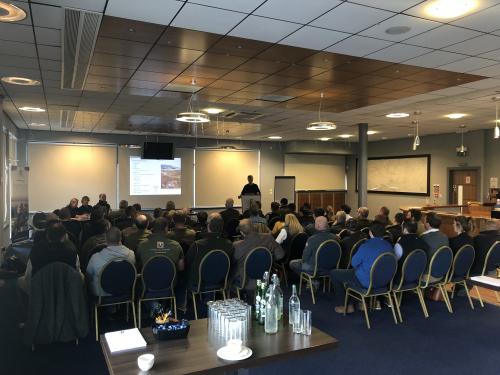The Cabinet Secretary for Environment, Climate Change and Land Reform, Roseanna Cunningham MSP, has commissioned the Werritty Committee (Grouse Moor Management Group) to examine areas of concern in moorland and grouse management (specifically peatland restoration, muirburn and the use of medicated grit) and to inform on the advantages of licensing these moors. This report is due to be published imminently, having gathered evidence from all relevant sectors involved in upland land management.
Our previous commissioned research has also examined the socioeconomic and biodiversity impacts of driven grouse moors in Scotland.
Currently 10% of Scotland’s land area is managed for shooting grouse, the success of which depends on control of the roundworm, Trichostrongylus tenuis. This worm causes fewer chicks to hatch and can kill grouse. The most practical and common technique used to control worms in grouse is by medicating grit.
|
All about medicated grit
|
How gamekeepers use medicated grit was one of the topics I explored through a fellowship supported by SEFARI Gateway and in collaboration with the Cairngorms National Park Authority (CNPA). By building connections with land users, and in particular gamekeepers, it was apparent that there was a lack of understanding on what constitutes responsible and sustainable use of medicated grit. As a consequence, two workshops were held, supported by SEFARI Gateway and run by Moredun staff, in collaboration with the Game and Wildlife Conservation Trust (GWCT). This knowledge exchange programme was very timely as I had also been asked to appear as an expert witness by the Werritty Committee on the use of medicated grit on Scottish grouse moors.
The workshops, held in Carrbridge and Perth, were attended by over 130 gamekeepers and were designed to provide information, but more importantly to give the keepers an opportunity to discuss what constitutes sustainable and best practice use of medicated grit, as highlighted below.
|
For best practice sustainable control of roundworms in grouse:
|
At both workshops, the keepers were proactive in asking questions and in contributing to following discussions on progress towards sustainable use of medicated grit across Scottish Estates. The atmosphere was very positive with many of the represented Estates already using diagnostics and following best practice guidelines and others starting to do so. Clearly this is a responsible attitude which, once adopted throughout the country, will demonstrate sustainable use of a product essential for the continued health and welfare of grouse. Requests have been made from attending keepers for further workshop events to keep them updated on this topic and any others that are relevant. Actions have been identified for the industry to look into, including certification courses on best practice use of medicated grit for both gamekeepers and prescribing vets, and in filling research and knowledge exchange gaps, which are currently being discussed within industry bodies.
This fellowship has had a real impact (my full report can be accessed here). By working in partnership with the Game and Wildlife Conservation Trust, the Moorland Groups and local vets, we developed and delivered a series of behaviour changing workshops. Feedback from the gamekeepers confirmed that the combination of expertise from scientists, vets and industry available at the workshops worked very well in putting over important messages for the sector to take on board. Further feedback from prescribing vets over this season, has also been that they have seen large increases in the proportions of Estates using diagnostics. This is great news and illustrates the impact of the workshops!
From a more personal perspective, my time spent on the fellowship was highly rewarding. Although I have a lot of experience in working with the livestock farming industry, I had little experience of working with gamekeepers and Estate owners. I soon found out that an interest in their work and a real desire to help yielded results. I was able to work effectively to build relationships which have lasted, as another series of Scottish Gamekeepers Workshops will be run this November to build on the work of the previous season. I have learned a great deal during this fellowship and enjoyed the challenge very much. Not only did I enjoy my visits to the Cairngorms but so did my dog Sula!
Dr Beth Wells, KE Specialist/Research Scientist, Moredun Research Institute
Beth’s fellowship has proven so successful, SEFARI Gateway have very recently decided to extend her valuable work and are delighted to support an additional workshop this November – so watch this space!
